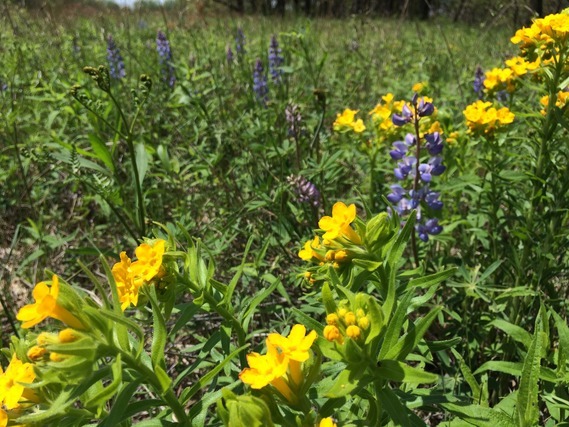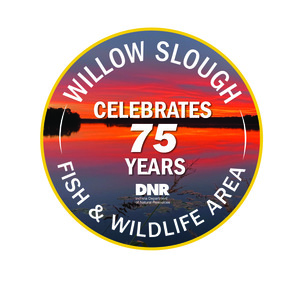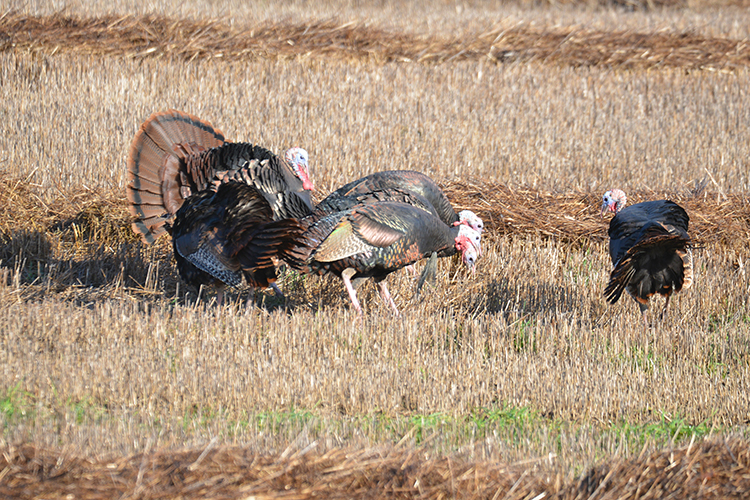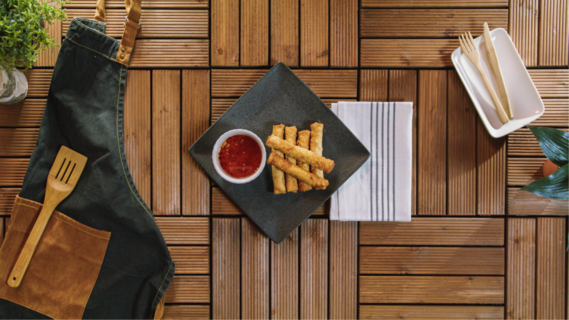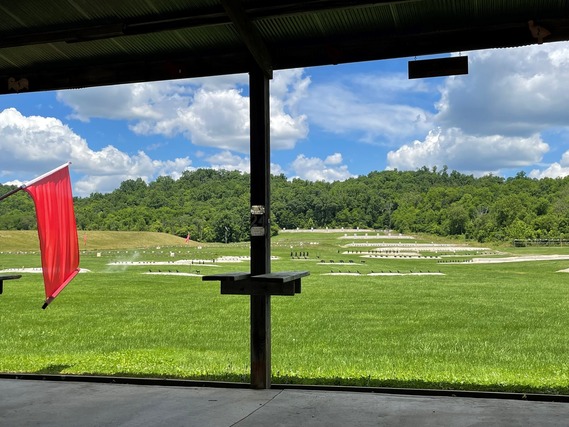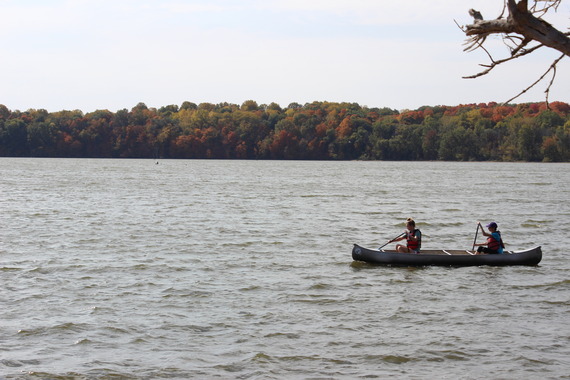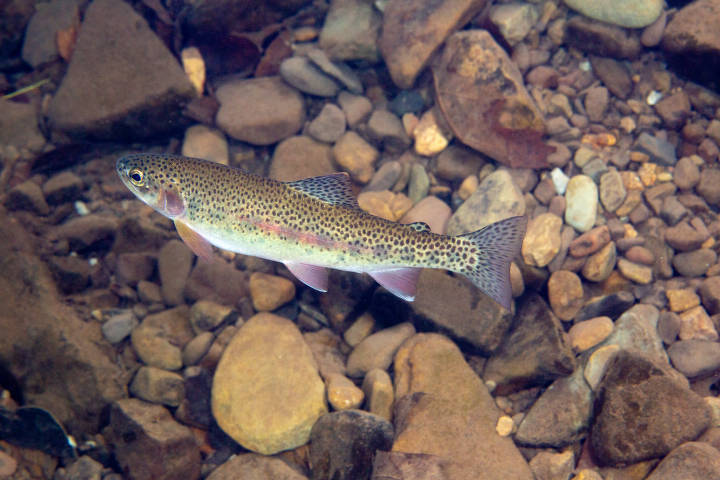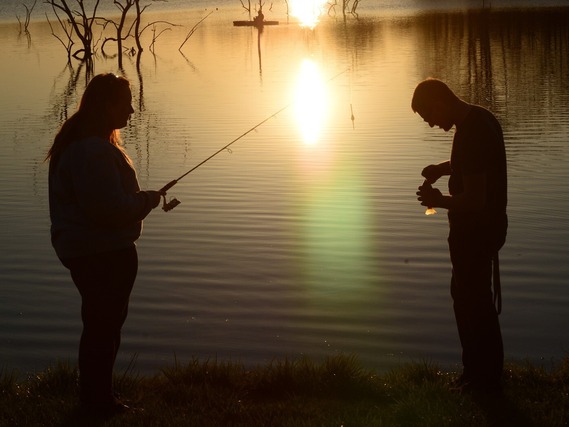
Yes, you may: First Free Fishing Day coming soon
Grab your gear and head outdoors—it’s time to fish. Indiana’s first Free Fishing Day of the year is May 12. On Free Fishing Days, Indiana residents do not need a fishing license or a trout/salmon stamp to fish the state’s public waters, so it’s the perfect time to bring your family and friends along to join the fun.
All other rules such as seasons, bag limits, and size limits apply. Find a fishing location near you with our Where To Fish map.
Educational events ramping up this summer
Looking to learn new skills? DNR will host a Learn to Shoot event for new shooters on June 18 at Atterbury Fish & Wildlife Area from 9 a.m. to 1 p.m. ET. Shooters of all skill levels are welcome, but the course content will be tailored toward those who are new to shooting and firearms. Plan for an exciting day on the range.
For those who want to hone their fishing techniques, DNR will also offer fishing classes throughout May and June. Topics range from fishing fundamentals to species-specific classes for those looking to target their favorite sportfish species. Visit our Learn to Fish page for more information.
Deer updates
First positive case of chronic wasting disease in Indiana
Indiana DNR has confirmed the state’s first positive case of chronic wasting disease (CWD) in an adult male white-tailed deer harvested in LaGrange County. CWD is a fatal infectious disease, caused by a misfolded prion, that affects the nervous system in deer. It can spread from deer-to-deer contact, bodily fluids, or through contaminated environments, and can remain in the soil for many years. CWD has been detected in 33 states, including the four states bordering Indiana (Ohio, Michigan, Illinois, and Kentucky). Because CWD had been detected in Michigan near the Indiana border, a detection in LaGrange County was likely.
There have been no reported cases of CWD infection in people, but the Centers for Disease Control and Prevention (CDC) recommends that hunters strongly consider having deer tested before eating the meat. The CDC also recommends that you do not eat meat from an animal that tests positive for CWD.
Indiana DNR’s CWD response plan is based on the latest scientific information about the effectiveness of CWD management options. Currently, there are no management actions that have been shown to cure deer of CWD, prevent deer from getting CWD, stop or significantly slow the spread of CWD, or eradicate it from the deer herd. Therefore, our plan focuses on monitoring the spread of the disease and informing Indiana residents how they can safely navigate CWD’s presence. DNR’s management efforts WILL NOT focus on eliminating CWD from the deer population in this area of LaGrange County because the disease is self-sustaining in nearby populations, making elimination unlikely.
If you see any sick or dead wildlife, please report your observations at on.IN.gov/sickwildlife. For questions, contact the DNR Deer Disease Hotline at 844-803-0002 to speak to a wildlife health biologist. For more information on CWD, visitour CWD webpage.
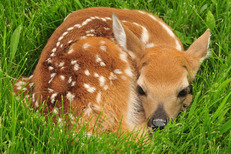
Keep wildlife wild: Leave fawns be
This spring, help DNR keep wildlife wild and slow the spread of CWD by leaving fawns be. During their first few weeks of life, fawns often hide by themselves and stay motionless to avoid predators while the mother is looking for food. Their color pattern and lack of scent help them remain hidden until their mother returns, which is only a few times a day, to reduce the chance of predators discovering them. It is not uncommon for mothers to leave their fawns in urban lawns.
If you find a fawn alone, even in your lawn, help us keep wildlife wild by letting it be, giving it space, and leaving the area. Its mother is likely nearby. If you encounter a fawn that appears to be injured, consider letting the circle of life take its course, as difficult as that decision might be. Sometimes wildlife can survive even when that potential is not immediately apparent. Not every baby animal will survive, and those that don’t will become food for another animal. Many animals rely on carcasses as their primary food source. If you plan to intervene with an injured or orphaned animal, learn about best practices at on.IN.gov/keepwildlifewild.
Before contacting a licensed wildlife rehabilitator for assistance, confirm that the fawn is truly injured or orphaned. Signs to look for include obvious signs of injury, lethargy, constant vocalization, an infestation of insects, or knowledge that the mother has been killed or has not returned in several days (remembering that the mother may return only at night). A list of permitted wildlife rehabilitators can be found aton.IN.gov/wildliferehab.
For dead wildlife removal best practices, visit on.IN.gov/livingwithwildlife.
Help slow the spread of CWD by not moving injured or orphaned fawns found in LaGrange, Steuben, Dekalb, and Noble counties to rehabilitators outside of this four-county area.
Photo courtesy of USFWS.

Public comment period opens for proposed changes to deer hunting rules
Indiana’s Natural Resources Commission (NRC) has opened a second public comment period for proposed changes to Indiana’s deer hunting rules before its members vote on the proposed changes. Most proposed changes are intended to make Indiana’s deer hunting rules easier to understand.
Public comments can be submitted online. Locate the “Submit Comments Here” link in the Rulemaking Docket for the Deer Hunting Rule Amendment Proposal. The deadline for public comments is May 20. The public hearing will be held on Monday, May 20, from 5:30-7:30 p.m. ET, both online and in person, with an in-person open house immediately before, from 4:30-5:30 p.m. ET at Atterbury Fish & Wildlife Area, located at 7970 S. Rowe St., Edinburgh, IN 46124. To attend the public hearing online, go to Microsoft Teams and enter Meeting ID: 213 479 076 835, Passcode: Ack2vu.
For more information on the proposed rule changes, visit our rule and regulations changes webpage. Questions about the proposed deer hunting rule changes should be directed to 812-334-3795 or indeerhotline@dnr.IN.gov.
Celebrate Willow Slough’s 75thanniversary
For 75 years, Willow Slough Fish & Wildlife Area has been supporting community and wildlife health with its more than 10,000 acres of diverse habitat and ample opportunities to enjoy the outdoors. The property offers hiking trails, lake views, picnic tables, camping, and access to hunting, fishing, wildlife watching, and more. In addition, the renovations on J.C. Murphey Lake are complete, and Indiana’s first parcel of land acquired through the Pheasants Forever & Quail Forever Build a Wildlife Area Program will be added to Willow Slough FWA this year. The new parcel of land will be converted to oak savanna habitat. On June 1 and June 2, please come celebrate Willow Slough FWA by joining guided hikes, kayak tours, and an evening campfire. All are welcome!
Take your turkey fun further
The hunt may be over soon, but the fun isn’t. Now is the time to create memories with your bird. You can preserve many parts of your turkey, such as the fan, spurs, and beards, to remind you of the experience. Plus, the meat of the wild turkey is excellent and healthy.
Watch our videos on how to process your turkey on our YouTube channel.
Turkey Lumpia, courtesy of R3 Clearinghouse.
Try Turkey Lumpia
Try something new this year with your turkey. Our R3 Clearinghouse has the perfect new recipe for you.
Ingredients:
- 1 turkey meat, cubed, skin off, tendons removed
- 3 oz. pork fat, cubed
- ¾ cup carrot, peeled, diced
- ¾ cup onion, diced
- 2 tbsp. green onion, diced
- 1 tbsp. garlic, minced
- 1 tbsp. soy sauce
- 1 tsp. salt
- 1 tsp. black pepper
- Lumpia wrappers (30-40 per pound of meat)
Tangy-sweet Sambal Oelek Dipping Sauce:
- 1 cup sugar
- ¾ cup white vinegar
- ½ cup water
- 2 tbsp. sambal oelek or other chili sauce
- 3 cloves garlic, minced
Steps:
- Combine turkey and all other ingredients, mix, and grind through the fine die of your meat grinder. Refrigerate for around 30 minutes to firm up the meat before rolling.
- Place 1.5 tablespoons of mix on a lumpia wrapper. Wrap lumpia.
- Roll lumpia. Use water to help close the wrap. Set aside.
- Make dipping sauce: Combine all dipping sauce ingredients. Simmer until sauce is reduced by half.
- Fry lumpia at 350°-375°F for 3 minutes until golden brown and internal temperature reaches at least 145°F.
- Allow lumpia to drain on a wire rack or a plate lined with paper towels.
- Serve with Tangy-sweet Sambal Oelek Dipping Sauce, shiso leaves, or lettuce.
For more information on wild turkey hunting, see our turkey hunting webpage.
New features at Walter Cline shooting range in Ripley County
Interested in honing your marksmanship skills this spring? Take a trip down to scenic Friendship and experience the new shooting range facilities at the Walter Cline Range, owned and operated by the National Muzzle Loading Rifle Association (NMLRA).
Thanks to a DNR shooting range grant, the Walter Cline Range now features modern restrooms, an updated trapshooting facility, including new concrete surfaces for improved access and wheelchair passage, a revitalized multi-station walking woods range and improved shooter support facilities. Federal Wildlife Restoration dollars helped fund this project.
You don’t have to be a muzzleloading rifle enthusiast to enjoy the Walter Cline Range. Modern centerfire rifle and rimfire competitions are held on a regular basis. Check out the Walter Cline website for details and the NMLRA calendar of events.
The DNR’s shooting range grant program provides funding for shooting range construction and development. Find more information about the grants on our website.
Paddle for data: Volunteer with the Paddlecraft Wildlife Index
If you’re looking for an excuse to launch your kayak, DNR has you covered—volunteer with the Paddlecraft Wildlife Index, a compilation of wildlife observations from people who use canoes, kayaks, or other nonmotorized paddlecraft on Indiana’s waterways. From June 1 to July 31, volunteer paddlers can help by completing a paddling trip postcard documenting the wildlife they observed while floating.
With your help, DNR can estimate changes in wildlife populations over time and gain insight into new locations where key wildlife populations may be living. Sign up online to receive a postcard and track your observations.
Rainbow trout, courtesy of USFWS.
Inland trout fishing season is open
Open trout season for inland streams has started, and it’s time to view the stockings near you. DNR has planned to stock nearly 63,000 rainbow and brown trout across 35 bodies of water. Find a list of 2024’s fish stockings on our website, or buy your fishing license and trout stamp online. For more fishing locations, visit our Where to Fish map.
Motus receivers can be installed on existing infrastructure (like the Goose Pond FWA Visitors Center, pictured above) to detect signals from wildlife wearing corresponding devices that pass within 9 miles of the antennas.
Motus towers installed at six public properties to track wildlife migration
DNR recently installed antennas at six Fish & Wildlife areas to broaden the coverage of the Motus Wildlife Tracking System. Motus technology involves small devices that can be fitted to very small animals, including insects, bats, and birds, to track their movement. Already, dozens of detections have been picked up by these antennas, including those of migratory birds like the Swainson’s thrush, endangered red knot, and Eastern whip-poor-will (an Indiana species of special concern). These detections show where and when wildlife wearing these devices travel through Indiana.
This project was made possible by funds from the Indiana Nongame Wildlife Fund.Learn more about the fund and donate online.
Upcoming hikes at Nature Preserves
Join Nature Preserves for two upcoming free field day hikes in May. Registration is required.
May 4: Moraine Nature Preserve, Porter County
Partnered with Old Growth Forest Network, led by Derek Nimetz, open to 25 individualsMoraine Nature Preserve is a 465-acre natural area located east of State Road 49 and south of State Road 6 within the Valparaiso Moraine Section of the Northwestern Morainal Natural Region of Indiana. Moraine Nature Preserve contains a combination of rolling ridges, steep hills, pothole wetlands, and a shallow pond. The property protects a mosaic of natural communities, including pond, shrub swamp, mesic upland forest, and dry-mesic upland forest. The site was dedicated in 1971 as a State of Indiana Nature Preserve. There have been four separate additions since the original dedication. For questions on accessibility or accommodations, contact Derek Nimetz at dnimetz@dnr.IN.gov.
May 23: Tolleston Ridges Nature Preserve, Lake County
Partnered with Lake County Parks and Recreation Department, led by Emily Stork, open to 30 individualsManaged by the DNR and Lake County Parks and normally closed to the public, Tolleston Ridges Nature Preserve is another small dune-and-swale complex of northwest Indiana. No formal trail exists. Meeting location and directions will be sent via email a week before the hike.
Note: Location is in Central time zone. For questions on accessibility or accommodations, contact Emily Stork at estork@dnr.IN.gov.
Celebrate World Migratory Bird Day
2024’s celebrations for World Migratory Bird Day fall on May 11 and Oct. 12. This year’s events focus on insects and their importance to migratory birds. Did you know that most baby birds cannot eat seed and instead rely on a heavy diet of insects for protein? You can successfully create habitat for insects by trying to plant at least three different species of native grasses and flowers blooming in spring, summer, and fall. Aim for a variety of colors and flower shapes to attract a variety of insects. If you aren’t ready to create habitat, here are some other ways to assist birds during migration:
- Help prevent window strikes by using external screens or staging feeders out of the flight path of windows.
- Reduce light pollution by turning off outdoor lights when not in use or installing light fixtures that concentrate light downward.
- Supervise all pets outdoors. It keeps both wildlife and pets safe.
If you are looking for information on how to increase habitat on your property to promote migratory bird habitat, contact a district wildlife biologist.
Recent news releases
Natural Resources Commission seeks input on proposed deer hunting rule changes
More
Buy a license
Hunting information
Where to Hunt
Fishing information
Where to Fish
Fish & Wildlife properties
The Indiana Natural Resources Foundation celebrates and preserves Indiana’s natural legacy by raising funds to support the Indiana Department of Natural Resources (DNR) and its programs. Together, we have helped expand public lands, restore wildlife habitat, and create outdoor educational and recreational opportunities for Hoosiers.
About Fish and Wildlife Management in Indiana
Fish and wildlife management and public access are funded by fishing and hunting license revenue and also through the Wildlife and Sport Fish Restoration Programs administered by the U.S. Fish & Wildlife Service. These programs collect excise taxes on sporting arms and ammunition, archery equipment, fishing equipment, and motor boat fuels. The money is distributed among state fish and wildlife agencies based on land size and the number of licensed anglers and hunters in each state. Find out more information about fish and wildlife management in Indiana at Wildlife.IN.gov.
This email was sent to Rhcosby@live.com using GovDelivery Communications Cloud, on behalf of: Indiana DNR – Division of Fish & Wildlife· 402 West Washington Street · Indianapolis, IN 46204


